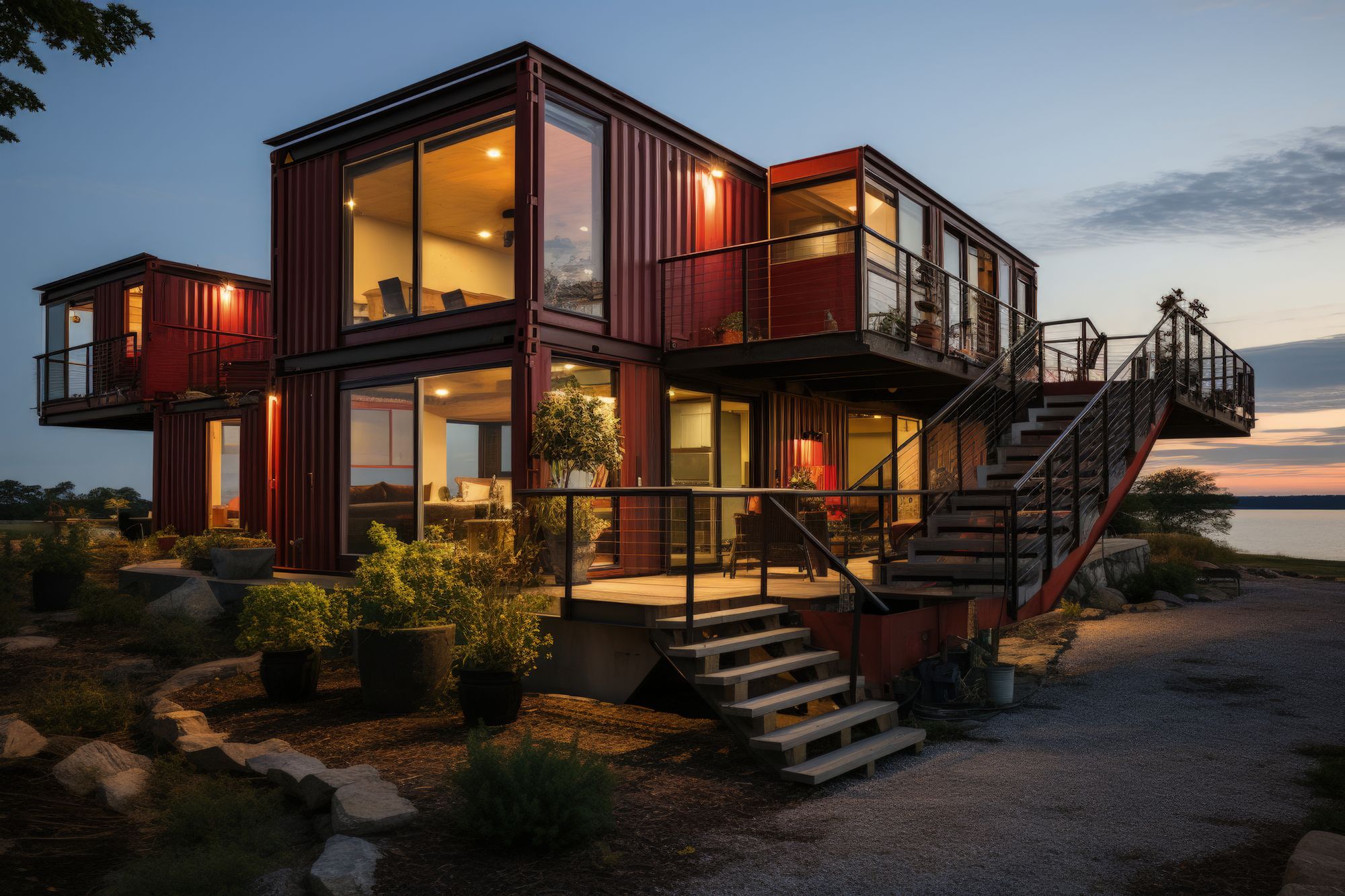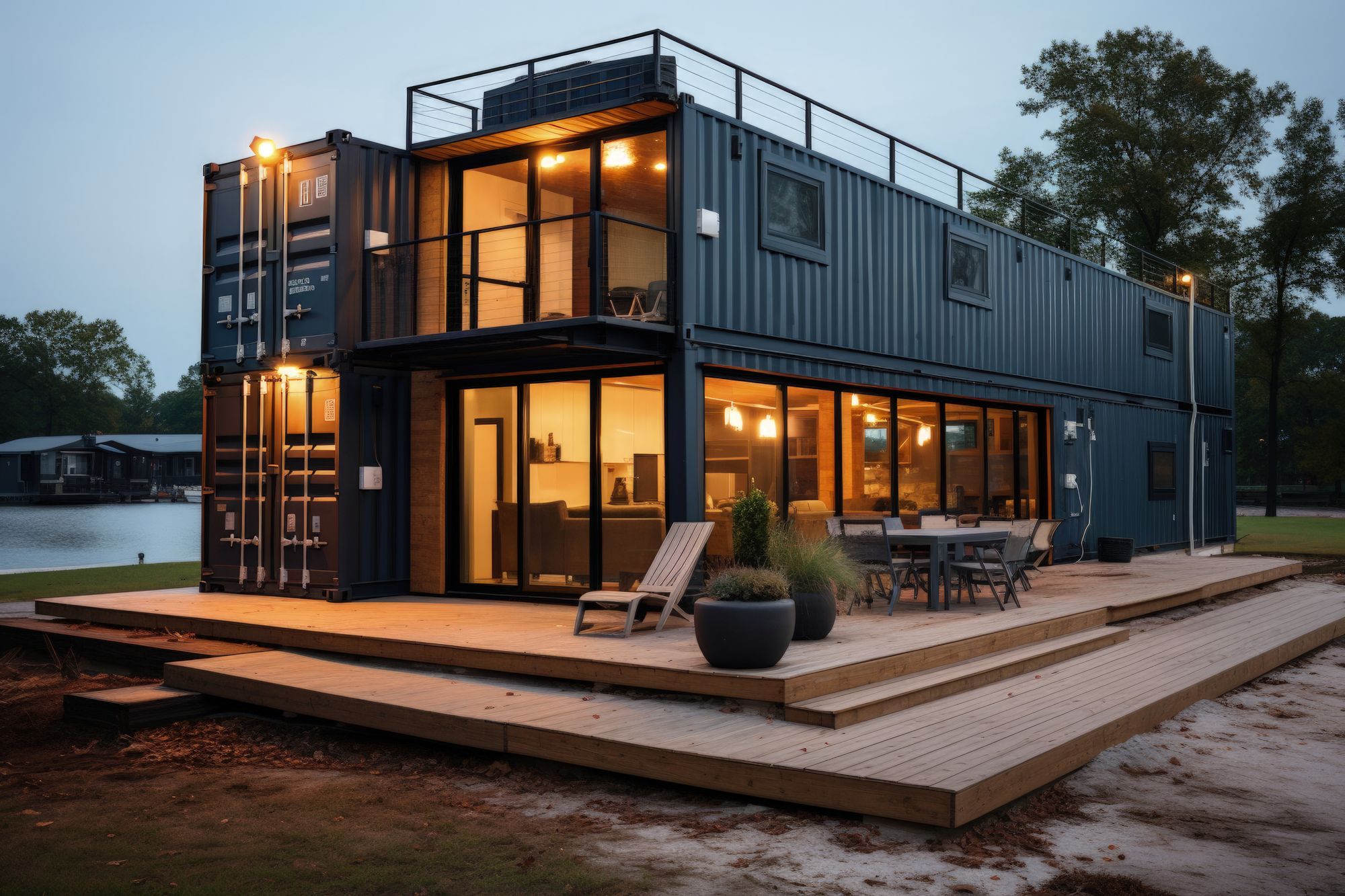Key Takeaways
- Container home financing offers an affordable and flexible way to own a home. It is important to understand what this financing entails to make informed decisions.
- There are various loan options available for container homes, each with its own pros and cons. The choice depends on individual circumstances and preferences.
- It's crucial to consider factors such as your budget, credit score, and financing terms before deciding on financing a container home.
- Comparing the different financing options can help you find the most cost-effective and suitable solution for your needs.
- There are steps to follow to secure financing for your container home. This includes choosing a lender, applying for a loan, and going through the approval process.
- There are practical tips to increase your chances of getting approved for a container home loan. These include maintaining a good credit score and providing complete and accurate information in your application.
- Despite some common misconceptions, financing container homes is a viable and often beneficial option for many people.
- Affordable financing options exist for container homes, which include specific loan programs, grants, or subsidies.
- Current mortgage rates for container homes can be competitive compared to traditional home mortgage rates.
- The process of financing a container home involves several steps, from choosing a lender to finalizing the loan agreement.
Understanding Container Home Financing: Navigating the Challenges
Financing a container home can present unique challenges due to its non-traditional nature, which often requires potential homeowners to navigate a complex landscape of lending standards and appraisal issues. Unlike traditional homes, container homes are not always recognized by all financial institutions as standard property types, which can complicate the loan approval process.
Appraisal Challenges: One of the primary obstacles in securing financing for a container home is the appraisal process. Container homes must be appraised for their market value, which can be difficult since comparable sales data—often used in traditional home appraisals—may be scarce. Appraisers must instead focus on the construction quality, permanence of the structure (whether it is movable or fixed to a foundation), and the home's adherence to local building codes and zoning regulations. This can affect the estimated value of the home, which in turn impacts the loan amount that lenders are willing to offer.
Loan Options: For financing, potential owners may consider several types of loans
- Construction Loans: These are typically used when building a new container home from scratch. These loans cover the cost of construction and then must be refinanced into a traditional mortgage once the building is complete.
- Mortgages: If the container home qualifies under lender guidelines, a traditional mortgage might be available. This requires the container home to be permanently affixed to the land and meet all local building codes and zoning requirements.
- Personal Loans: Due to the unconventional nature of container homes, personal loans can sometimes offer a more flexible financing option, though they may come at higher interest rates than mortgages.
Lender Selection: It’s crucial to find lenders who are familiar with or specialize in non-traditional housing. These lenders are more likely to provide realistic and favorable financing options because they understand the specifics of container homes and the potential for appreciation in value.
By understanding these aspects, prospective container homeowners can better prepare themselves for the financial process involved in owning one of these unique properties. This preparation includes researching lenders well-versed in non-traditional properties and getting an accurate appraisal to ensure financing aligns with the home's true value.
Types of Loans Available for Container Homes: Understanding Requirements
Financing a container home involves navigating a variety of loan options, each with its own set of requirements, terms, and conditions specifically suited for non-traditional properties like container homes. Here’s a detailed look at the most common types of loans available and what you need to know about each:
- Construction Loans
- Purpose: Designed specifically for financing the construction of new buildings, including container homes.
- Down Payment: Typically requires a down payment of 20% to 30%, which is higher than some other types of loans due to the perceived risk associated with new construction financing.
- Term Length: Generally short-term loans, usually lasting one year or until the construction is completed.
- Special Conditions: After construction, these loans usually need to be refinanced into a traditional mortgage. Lenders might also require detailed construction plans and proof of a contract with a qualified builder.
- Traditional Mortgages
- Purpose: Can be used for purchasing land and permanently affixed container homes that meet all local building codes and zoning requirements.
- Down Payment: Varies, but typically ranges from 5% to 20% depending on the lender’s policies and the borrower’s creditworthiness.
- Term Length: Long-term financing options are available with terms ranging from 15 to 30 years.
- Special Conditions: Container homes must be fixed to a permanent foundation and comply with local housing standards to qualify. Not all lenders offer mortgages for container homes, so it may require some research to find an accommodating lender.

- Home Equity Loans
- Purpose: Suitable for those who already own property and wish to build or purchase a container home on their land.
- Down Payment: Not applicable as the loan is based on the equity built up in the existing property.
- Term Length: Terms can range from 5 to 30 years.
- Special Conditions: The borrower’s existing home is used as collateral, putting it at risk if repayments are not made.
- Personal Loans
- Purpose: Can be used for buying or constructing container homes, especially when other loan options are not feasible.
- Down Payment: None required, as these are unsecured loans.
- Term Length: Shorter terms ranging from 1 to 7 years.
- Special Conditions: Interest rates are generally higher than those for secured loans, and the amount you can borrow might be limited based on your income and credit score.
- Manufacturer Financing
- Purpose: Some container home manufacturers offer their own financing solutions, making it easier to purchase directly from them.
- Down Payment: Varies by manufacturer and may be lower than traditional financing options.
- Term Length: Can vary widely but generally offers flexible terms tailored to the buyer’s needs.
- Special Conditions: Often contingent on purchasing from the specific manufacturer, which might limit your options for customization.
When considering financing for a container home, it’s important to compare these options closely, taking into account your financial situation, the specifics of your project, and long-term affordability.
Consulting with a financial advisor who understands non-traditional property financing can also provide valuable insights and help you make the best decision for your circumstances.
Factors to Consider Before Financing a Container Home
When planning to finance a container home, it's important to consider several key factors to ensure a smooth and successful process.
- Budget: The first step in financing a container home is to determine your budget. This includes considering the cost of the container, the construction or modification costs, the land, and any additional costs for interior fittings, utilities, and landscaping.
- Credit Score: Your credit score plays a significant role in your ability to secure a loan and the interest rate you'll receive. A higher credit score generally results in more favorable loan terms.
- Loan Type: Different loan types come with varying interest rates, terms, and requirements. Understanding the advantages and drawbacks of options like personal loans, construction loans, or mortgages can help you choose the best fit for your situation.
- Lender: Not all lenders offer loans for container homes due to their unconventional nature. Research and find a lender who understands and supports this type of housing.
- Future Plans: Consider your long-term plans. If you plan to live in the container home for many years, a mortgage might be a good option. If it's a short-term project, a personal or construction loan might be more suitable.
- Insurance: Securing insurance for a container home can be challenging due to its non-traditional construction. Check with insurance providers before finalizing your financing plans.
- Location: The location of your container home can affect both the cost and feasibility of your project. Some areas have zoning laws or restrictions that could affect your plans.
By considering these factors, you can make informed decisions and navigate the financing process with confidence.
Comparing Financing Options for Container Homes
Choosing the right financing option for your container home can greatly impact the overall cost. Here's a comparison of the most common financing options:
- Personal Loans: Personal loans can be obtained relatively quickly, often without the need for collateral. This makes them a good choice for those with strong credit, who can secure lower interest rates. However, for those with less-than-stellar credit, personal loans can come with high interest rates, making them an expensive option.
- Home Equity Loans: Home equity loans are an excellent option for existing homeowners. They offer lower interest rates compared to personal loans, and the interest paid is typically tax-deductible. However, they require you to have enough equity in your existing home and come with the risk of losing your home if you fail to repay the loan.
- Construction Loans: Construction loans are short-term loans specifically designed for building or major home renovations. They're interest-only during the construction phase, and the lender pays out the money in stages. The major drawback is that they often come with higher interest rates and stringent approval requirements. Once construction is complete, you'll need to refinance into a long-term mortgage which could lead to additional closing costs.
- Mortgages: Mortgages offer lower interest rates and longer repayment terms, making them a more affordable option over time. However, securing a mortgage for a container home can be challenging as many lenders are wary of this non-traditional form of housing.
Therefore, when comparing financing options for your container home, consider factors like the loan term, interest rate, your credit score, and your financial stability. The best financing option will depend on your individual circumstances and long-term housing plans.

Steps to Secure Financing for Your Container Home
Securing financing for a container home involves several steps. Here's a step-by-step guide to help you navigate the process:
- Step 1: Assess Your Budget: Determine how much you can afford to borrow for your container home. This should include the cost of the container, construction, land, furnishings, and ongoing maintenance.
- Step 2: Check Your Credit Score: Your credit score will significantly influence the loan terms you receive. Ensure you have a good credit score, or take steps to improve it before applying for a loan.
- Step 3: Choose the Right Loan Type: Research various loan types and their terms to determine the best fit for your situation. Consider personal loans, home equity loans, construction loans, or mortgages, depending on your needs and circumstances.
- Step 4: Research Lenders: Not all lenders offer loans for container homes. Find a lender who understands and supports container home projects. Compare their rates, terms, and customer reviews to make an informed decision.
- Step 5: Gather Necessary Documents: Prepare all necessary documents for your loan application. This typically includes proof of income, tax returns, credit history, and a detailed plan for your container home project.
- Step 6: Apply for the Loan: Once you've chosen a lender and prepared all necessary documents, submit your loan application. Ensure you understand all the terms and conditions before signing.
- Step 7: Close on Your Loan: If your loan is approved, the final step is to close on your loan. This involves signing a legal agreement that details the loan terms and repayment plan. Once this is done, you can begin your container home project with the funds you have secured.
Remember, securing financing is a crucial step in your container home project. Take your time to understand each step and make informed decisions.
Tips for Getting Approved for a Container Home Loan
Obtaining a loan for a container home can be challenging. However, there are several strategies that can increase your chances of approval:
- Maintain a Good Credit Score: A high credit score is a key factor lenders consider. Regularly check your credit report, pay your bills on time, and try to reduce your debt to keep your credit score in good standing.
- Save for a Down Payment: A significant down payment reduces the lender's risk and demonstrates your financial responsibility. Aim for a down payment of 20% or more of the total cost.
- Stable Income: Lenders prefer borrowers with a stable, consistent income. This verifies your ability to make regular payments.
- Manage Your Debt-to-Income Ratio: Your debt-to-income ratio is the amount of debt you have compared to your overall income. Lenders prefer a ratio of 36% or less, so try to minimize your existing debts.
- Work with a Specialist: Working with a lender or broker who has experience with container home loans can be beneficial. They can guide you through the process and help you present your project in the best light.
- Prepare a Detailed Plan: Lenders appreciate well-thought-out plans. Prepare a detailed plan of your container home project, including costs, timeline, and contractors. This demonstrates your seriousness and planning, increasing your chances of approval.
- Consider Insurance: Securing insurance for a container home can be challenging. Consider finding an insurer early in the process, as this can increase your credibility with the lender.
By following these tips, you can increase your chances of securing a loan for your container home project.
Navigating the Process of Financing a Shipping Container Home
Securing financing for a shipping container home can be a complex process, but with the right preparation, it can be made smoother. Here's a brief guide to help you navigate:
- Initial Research and Preparation: Start by researching prospective lenders who offer loans for container homes. Understand their requirements, interest rates, and terms. Prepare a rough budget for your project, including costs for the container, land, construction, and any necessary renovations.
- Document Collection: Gather all necessary documentation. This typically includes proof of income (like pay stubs or tax returns), credit history, details of your debt obligations, and a comprehensive plan for your container home project.
- Loan Application: Once you have all your documents ready, you can apply for the loan. Each lender has a different application process, but generally, it includes submitting your documents and completing an application form.
- Approval and Disbursement: If your application is approved, the lender will give you a loan offer. Review it carefully before signing. The lender will then disburse the funds, often directly to the contractor or builder.
- Construction and Repayment: Once the funds are disbursed, construction can begin. You'll start repaying the loan as per the agreed terms.
The timeline for this process varies widely depending on the lender, your preparedness, and the complexity of the project. However, typically, it can take anywhere from a few weeks to a few months. Being well-prepared and organized can help speed up the process.

Common Misconceptions About Financing Container Homes
There are several misconceptions about financing container homes, but here we debunk a few common ones:
- Container Homes Can't Be Financed: Many believe that it's impossible to get financing for container homes. However, it's not the case. Although it can be challenging due to their non-traditional nature, many lenders are starting to recognize them as viable alternatives to traditional homes.
- Only Personal Loans Are Available: While personal loans are commonly used for container homes, they're not the only option. Construction loans, home equity loans, or even specialized tiny home loans can potentially be used.
- Container Homes Are Always Cheaper: While container homes can be more affordable than traditional homes, the final cost depends on several factors, including land cost, design complexity, and customization level. Financing should be planned accordingly.
- You Don't Need Good Credit to Finance a Container Home: Just like any other home, your credit score significantly impacts your ability to secure financing for a container home. It influences your loan terms and interest rates.
- Container Homes Don't Appreciate in Value: This is a common myth, but the reality is that well-maintained and well-located container homes can appreciate in value, just like traditional homes.
Remember, every financial institution has different policies and procedures. It's crucial to do your research and consult with various lenders to understand your options better.
Affordable Financing for Container Homes
Financing a container home can be more affordable than you think. Numerous options exist for borrowers, including specific loan programs, grants, and subsidies:
- FHA Loans: The Federal Housing Administration (FHA) offers loans with lower down payments and credit requirements than many conventional loans. While there may be specific requirements for container homes, this can be a viable option.
- USDA Loans: If you plan to place your container home in a rural area, you might qualify for a USDA loan. These loans offer competitive interest rates and often require no down payment.
- Home Equity Loans or Lines of Credit (HELOCs): If you already own a home, these can provide a way to finance your container home. They use your current home’s equity as collateral.
- Grants and Subsidies: Some states or local municipalities offer grants and subsidies for green or sustainable housing, which can include container homes.
- Crowdfunding or Personal Loans: While not traditional, these methods can also be used to finance your container home. Crowdfunding can be particularly useful if your project has a unique or innovative angle.
Remember, it's crucial to carefully research all potential financing options, assess the terms and conditions, and consider the long-term impacts on your financial health before making a decision.
Container Home Mortgage Rates
Mortgage rates for container homes can vary significantly depending on the lender, borrower's creditworthiness, and the specific circumstances of the build.
- Comparison to Traditional Home Mortgage Rates: Container homes often fall into a unique category of lending due to their unconventional nature. Traditional home loans are typically backed by Fannie Mae or Freddie Mac, but these institutions often do not back container homes, leading to different rates.
- Factors Influencing Rates: A borrower's credit score, debt-to-income ratio, and the size and design of the container home can significantly impact mortgage rates. Lenders may charge higher rates due to perceived risks associated with container homes.
- Average Mortgage Rates: As of late, mortgage rates for container homes tend to be slightly higher than traditional home rates. For instance, while you might secure a traditional home loan at 3-4%, container home loans may come in at about 5-6%. However, this is not a hard and fast rule and rates can fluctuate based on economic conditions and lender policies.
- Seeking Favorable Rates: To secure the best possible mortgage rates, prospective container home owners should maintain a good credit score, shop around for the best loan terms, and consider working with lenders who specialize in container or tiny homes.
Remember, while container home mortgage rates may be slightly higher, the overall cost of a container home is often significantly less than a traditional home, making it an affordable option in the long run.
How to Finance a Container Home
Financing a container home involves several steps that mirror the traditional home financing process, with a few unique considerations to bear in mind:
- Research Your Options: Begin by understanding the different types of loans available. This includes personal loans, construction loans, or specialized tiny home loans. The FHA and USDA also offer loan programs that might be applicable.
- Find a Lender: Not all lenders are open to financing container homes due to their non-traditional nature. Look for lenders who specialize in tiny homes or alternative housing options.
- Get Pre-Approved: After finding a potential lender, the next step is to get pre-approved. This involves providing the lender with information about your income, expenses, and credit score.
- Apply for the Loan: Once pre-approved, you can formally apply for the loan. You'll need to provide more detailed information and possibly pay for an appraisal of the container home.
- Close on the Loan: After your application is approved, you will close on the loan. This involves signing all the necessary paperwork and beginning the repayment process.
Remember, each lender will have its own specific requirements and process. It's crucial to thoroughly research and understand these before proceeding.

Real-Life Scenarios
Here are a few examples that illustrate how individuals have navigated the unique challenges associated with financing container homes:
- Austin, Texas Couple's Experience: A young couple decided to embrace a minimalist lifestyle by building a shipping container home in Austin, Texas. Initially, they faced rejection from traditional banks due to the unconventional nature of their project. However, their persistence paid off when they discovered a local credit union that was open to innovative housing solutions. They secured a construction loan which was later converted into a traditional mortgage upon the completion of the home.
- Montana Shipping Container Builders: In Montana, prospective container home owners have access to a variety of specialized builders. These builders not only construct the homes but also assist in the financing process, often through connections with local financial institutions familiar with container homes. This collaboration between builders and financiers smoothens the financing process, providing a streamlined path from conception to completion.
- Backcountry Containers Custom Solutions: A family-owned business specializing in container homes offers both standard and custom container homes. They help customers through the financing process, often suggesting specific lenders that understand and support container home projects. This tailored approach ensures that customers receive the best possible financing options that fit their unique needs.
These examples highlight the importance of thorough planning, the value of finding the right financial partners, and the benefits of working with experienced builders. They serve as practical guides that can inspire potential container home owners and help them anticipate the challenges they might face in financing their projects.
FAQ Section: Financing Container Homes
- What is involved in the appraisal process for container homes? Appraising a container home can be complex due to their unique nature. Appraisers must consider the quality of construction, the permanence of the structure, local market conditions, and how well the home conforms to building codes. Since there may be fewer comparable sales, appraisers might also use cost-based approaches or consider the income potential if the home is to be rented.
- How does financing a container home affect my insurance? Insuring a container home can differ from standard home insurance due to the unconventional building materials and construction techniques. It's essential to find an insurance provider that recognizes and covers container homes. The insurance might cover the cost of replacing the structure and liability coverage, but premiums could vary based on the container home’s design and location.
- Are there specific zoning laws for container homes? Zoning laws for container homes vary significantly by locality. Some areas may have restrictions on the placement of such homes or require that they meet certain aesthetic standards to blend in with other homes in the area. Before proceeding with construction, check with your local zoning office to ensure that your container home project complies with all local ordinances and codes.
- What are the typical financing options available for container homes? Financing options for container homes include personal loans, home equity loans, construction loans, and, in some cases, specialized container home mortgages. Each option has different requirements for credit score, down payment, and collateral. It’s important to compare these options to find the one that best suits your financial situation.
- Can I get a mortgage for a container home? Obtaining a mortgage for a container home is possible but can be more challenging than for a traditional home. Lenders may require that the container home be permanently affixed to a foundation and meet all local building codes. Some lenders specialize in non-traditional properties like container homes, so seeking out these institutions can be beneficial.
- What should I consider before deciding to finance a container home? Before financing a container home, consider the total cost, including land, design, construction, and utilities. Evaluate your financial stability, credit score, and the potential impact on your long-term financial goals. Understanding the local real estate market and potential resale value of the container home is also crucial.
- How can I increase my chances of loan approval for a container home? To enhance your chances of getting approved, maintain a good credit score, gather comprehensive documentation about your financial status, and provide a detailed plan for the construction and use of the container home. Working with lenders familiar with container homes or non-traditional properties can also improve your chances.
Conclusion
In conclusion, financing a container home is a viable and affordable option that can be achieved through various financing methods. From traditional loans like FHA or USDA to using home equity or applying for grants and subsidies, there are several ways to make your container home dream a reality.
Understanding the unique nature of container homes and how they affect mortgage rates is essential. These rates may vary depending on several factors, including lender policies, the borrower's creditworthiness, and the specifics of the container home build.
The financing process involves researching your options, preparing your financial profile, choosing the right lender, and applying for the loan. Make sure to do due diligence and thoroughly understand the terms and conditions before committing to any loan agreement.
There's a lot to consider when embarking on your container home journey, but with careful planning and the right financial strategy, it can be an exciting and rewarding experience. We encourage you to take the next step, armed with this knowledge, towards realizing your dream of owning a container home.






